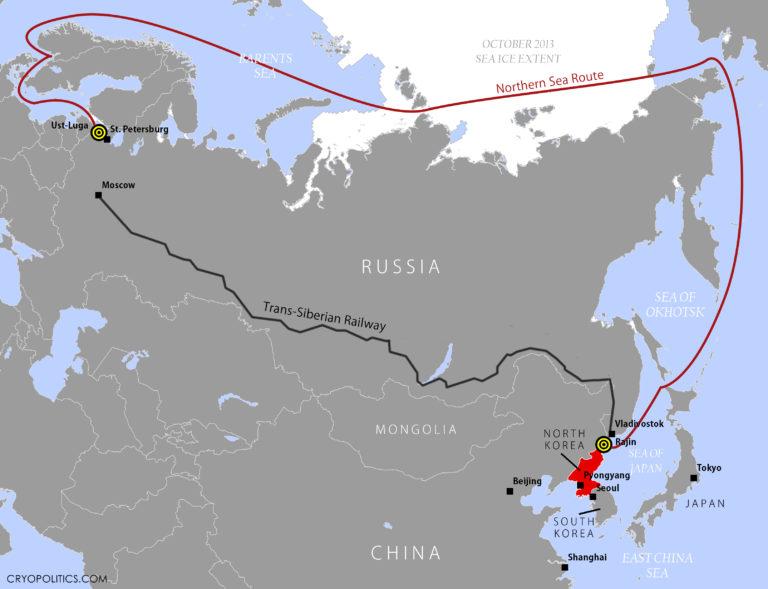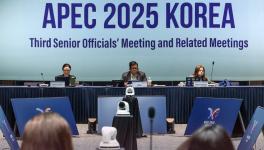Russia and China Have Shared Vision for North Korea

North Korean leader Kim Jong Un (R) and Russian Defence Minister Sergey Shoigu at a pavilion displaying North Korea’s newest 3-stage solid-fuelled ICBM Hwasong-18, Pyongyang, July 26, 2023.
The three-day state visit on July 25-27 by Russian Defence Minister Sergey Shoigu, accompanied by a military delegation to Pyongyang is the first-ever such high-level visit from Moscow in the post-Soviet era. Shoigu’s meeting with the North Korean leader Kim Jong Un on Wednesday altogether elevates what would have passed as a friendly gesture by the Kremlin on the 70th anniversary of the armistice that led to a cessation of Korean War hostilities to an altogether different universe.
At the most obvious level, it punctures a hole into the iron curtain of sanctions that the US built around North Korea. But Shoigu’s visit, coinciding with the Africa Summit in St. Petersburg chaired by President Vladimir Putin, needs to be seen as part of Russia’s message that it has returned with a bang on the centre stage of world politics.
The icing on the cake was a conducted tour of North Korea’s arsenal of missiles capable of carrying nuclear warheads, including its newest ballistic missile achievement Hwasong-18, which Kim personally undertook for the Russian military delegation.
The North Korean News Agency [NKNA] reported that Shoigu handed over a hand-written letter from Putin to Kim. It commented that “Recollecting with deep emotion the history of deep-rooted DPRK-Russia friendship, they at the talk exchanged the appraisal and opinions on the matters of mutual concern in the field of national defence and security and on the regional and international security environment and reached a consensus of view on them… [Emphasis added]
“The meeting between Kim Jong Un and Sergei Shoigu at an important time serves as an important occasion in further developing the strategic and traditional DPRK-Russia relations as required by the new century and further boosting in depth the strategic and tactical collaboration and cooperation between the two countries in the field of national defence and security to cope with the ever-changing regional and international security environment.” [Emphasis added.]
Russia’s Defence Ministry said Shoigu’s visit “would contribute to strengthening bilateral military ties and mark an important stage in the development of cooperation between the two countries”.
The accent in the North Korean readout is unmistakably on defence and security concerns, calling attention to the volatile environment in the Far East, and specifically on “strategic and tactical collaboration and cooperation.” Moscow refuted Western reports about military cooperation with North Korea. A new page is possibly opening.
Shoigu’s visit took place alongside the visit by Li Hongzhong, vice chairman of China’s National People’s Congress Standing Committee, signalling Russia and China “stand close” to North Korea — to borrow from a Global Times commentary — in response to the Biden Administration accelerating the deepening of a trilateral alliance between Washington, Tokyo and Seoul.
Washington is taking advantage of the political transition in South Korea with the election of the pro-western South Korean president Yoon Suk-Yeol last year in May who reversed his predecessor Moon Jae-In’s independent foreign policy trajectory toward Moscow and Beijing and altogether gave up the efforts to work out a detente with Pyongyang.
The US approach to the Far East draws comparison with its strategy in the Middle East where also it used to whip up Iranophobia and block any regional security process from crystallising, which helped boost its military presence in the region and promoted massive scale of arms exports. The main difference lies in the thrust of Washington’s Far East strategy which lies in containing China and Russia.
There is no question that the US is aggravating the situation in Asia by provoking Pyongyang and undermining the situation on the Korean Peninsula to keep it in a state of suspended animation that can be revisited anytime. The recent successive visits in July by two US nuclear submarines to the South Korean naval bases is a case in point.
In the recent period, the frozen confrontation between the two Koreas is constantly approaching escalation due to the deepening military cooperation between Washington and Seoul. A defining moment came in April when Biden and Yoon signed the Washington Declaration on deterring North Korea, which involves the creation of an advisory group on issues in the nuclear sphere and greater frequency of the appearance of American strategic weapons, as well as the visits of nuclear submarines to South Korea.
To be sure, the doubling down by Washington provoked a sharp reaction from Pyongyang and a vicious circle is forming in the absence of any interest on the American side to re-engage with Pyongyang. In effect, therefore, Americans are escalating the situation under the pretext of supporting South Korea.
Plainly put, this creates synergy for the US’ capacity to counter the Sino-Russian axis in the Asia-Pacific region. Izvestia newspaper reported last week quoting defence ministry sources in Moscow that a strengthening of Far East deployment is under consideration and that may include the basing of strategic missile carriers Tu-160 “White Swan” in the Amur region — a multi-mode supersonic strategic bomber with variable wing geometry, designed to hit in the deep rear at speed up to 2000 km/h.
The military expert Yuri Lyamin told Izvestia, “Special attention should be paid to Japan, with which we [Russia] still have territorial disputes over the Southern Kuril. Recently, this country [Japan] has been increasing its military spending, and also plans to develop shock weapons systems. Therefore, it is necessary to strengthen our deterrence forces in order to neutralise the threat from this direction.”
However, the geopolitics of the Far East has other dimensions too. The commercial value of the Arctic shipping route is in the spotlight, “which is an important area where China and Russia have potential and should strengthen collaboration,” Global Times wrote this week.
Russia is currently testing the Arctic shipping route with a cargo of crude oil for China, which is expected to arrive on August 12 at Rizhao in East China’s Shandong Province. This route could reduce the maritime distance between Europe and Northeast Asia by almost one-third, compared with the Suez route, which is currently used for most of the Russian oil exports to China and India.
No doubt, climate change fuels interest in Arctic shipping. But this is also setting a new stage of global power competition, involving both political and economic interests for trade between Asia and Europe. The strategic significance is profound, since the Northern Route is not under American control, unlike Malacca Straits.
The Global Times wrote: “From the perspective of geopolitics, early planning and precaution in terms of the diversification of shipping routes is paramount to China’s economic and trade security. Therefore, China needs to team up with Russia on the development of new shipping routes in the Arctic for their long-term strategic interests.”
Suffice to say, the deepening cooperation between the Chinese and Russian navies, especially joint patrol, etc. — is a game changer in the geopolitics of the Far East and Western Pacific.
Where does North Korea come in? Simply put, Rajin Port, located on North Korea’s northeast coast, happens to be the most northerly ice-free port in Asia.

Rajin could become a “logistics hub” if it is linked into the Trans-Siberian Railway. Already, there is a railway connecting Russia and North Korea via the crossing at the Tumen River to reach the port at Rajin (as per a 2008 agreement signed between the railways of the two countries.

A Special Economic Zone in Ranjin dovetails on the one hand into the Arctic shipping network while on the other hand, falls squarely within the group of ports in Northeast Asia at which ships transiting the Northern Sea Route could arrive at or depart, three of whom — Busan, Qingdao, and Tianjin — also being the world’s top 10 busiest container ports.
Indeed, the US plot to keep tensions high in the situation surrounding North Korea is self-evident. To really turn Rajin into a logistics hub would likely require massive changes to the political situation on the Korean Peninsula.
Shoigu’s pathbreaking visit to Pyongyang has a much bigger agenda to integrate North Korea into the geoeconomics of Eurasia. To view it in zero-sum terms will not do justice to Russia’s intellectual resources to plan for the future with a far-sighted vision. Don’t be surprised if Shoigu’s talks in Pyongyang will figure in Putin’s forthcoming visit to China in October with a focus on the Belt and Road Initiative.
M K Bhadrakumar is a former diplomat. He was India’s ambassador to Uzbekistan and Turkey. The views are personal.
Get the latest reports & analysis with people's perspective on Protests, movements & deep analytical videos, discussions of the current affairs in your Telegram app. Subscribe to NewsClick's Telegram channel & get Real-Time updates on stories, as they get published on our website.
























